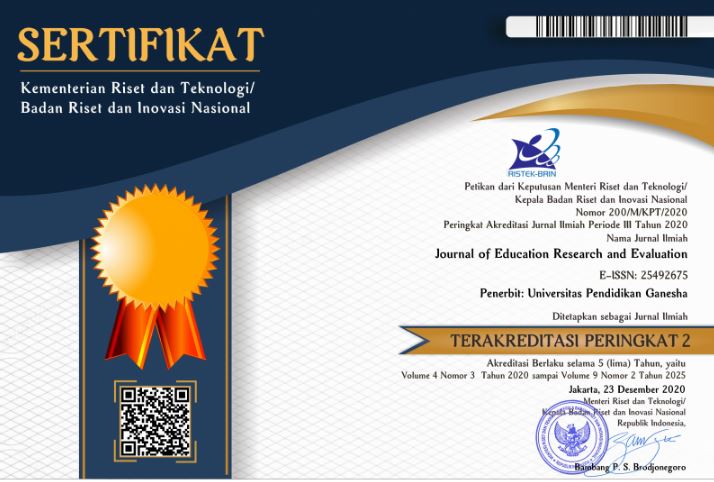The Analysis Of Multiple-Choice Test Quality For Reading III Class In English Education Department, Universitas Pendidikan Ganesha Bali, Indonesia
DOI:
https://doi.org/10.23887/jere.v1i1.10060Kata Kunci:
Classical test theory, English, Multiple-choice test, ReadingAbstrak
This study aimed at investigating the quality of 40-item multiple-choice taken from Reading III class in English Education Department. It was carried out in order to get clearer picture and provide feedbacks on how the Critical Reading test for the new curriculum should be developed and what factors should be taken into account when developing the test. The data were taken from 24 fourth semester students in English Education Department, Unidksha, Bali who took the reading test. The data were analyzed by conducting Classical Test Theory analysis with the assistance of jMetrik software. In general, the result shows that the test was consistent but it was easy and only 40% of total items are eligible to be used. Along the findings and discussion, some feedbacks are provided for future development for the reading test.
Referensi
Afflerbach, P., Cho, B. Y., & Kim, J. Y. (2015). Conceptualizing and assessing higher-order thinking in reading. Theory Into Practice, 54(3), 203-212.
Anderson, L. W., Krathwohl, D. R., & Bloom, B. S. (2001). A taxonomy for learning, teaching, and assessing: A revision of Bloom's taxonomy of educational objectives. Allyn & Bacon.
Crocker, L., & Algina, J. (1986). Introduction to classical and modern test theory. Holt, Rinehart and Winston, 6277 Sea Harbor Drive, Orlando, FL 32887.
Donnelly, Christina (2014) "The Use of Case Based Multiple Choice Questions for Assessing Large Group Teaching: Implications on Student's Learning," Irish Journal of Academic Practice: Vol. 3: Iss. 1, Article 12.
Frisbie, D. A., & Ebel, R. L. (1991). Essentials of educational measurement.
Hassan, S., Amin, R. M., Bt. Mohd Amin Rebuan, H., & Thwe Aung, M. M. (2016). Item analysis, reliability statistics and standard error of measurement to improve the quality and impact of multiple choice questions in undergraduate medical education in Faculty of Medicine at UniSZA. Malaysian Journal of Public Health Medicine, 16(3), 7-15.
Hopkins, C. D., & Antes, R. L. (1989). Classroom testing: construction. FE Peacock Pub.
Liu, O. L., Frankel, L., & Roohr, K. C. (2014). Assessing Critical Thinking in Higher Education: Current State and Directions for Next‐Generation Assessment. ETS Research Report Series, 2014(1), 1-23.
Meyer, J. P. (2014). Applied measurement with jMetrik. Routledge.
Tankersley, K. (2003). Threads of reading: strategies for literacy development. ASCD.
Yu, J. (2015). Analysis of critical reading strategies and its effect on college English reading. Theory and Practice in Language Studies, 5(1), 134.
Unduhan
Diterbitkan
Cara Mengutip
Terbitan
Bagian
Lisensi
Authors who publish with the Journal of Evaluation and Research in Education (JERE) agree to the following terms:
- Authors retain copyright and grant the journal the right of first publication with the work simultaneously licensed under a Creative Commons Attribution License (CC BY-SA 4.0) that allows others to share the work with an acknowledgment of the work's authorship and initial publication in this journal.
- Authors are able to enter into separate, additional contractual arrangements for the non-exclusive distribution of the journal's published version of the work (e.g., post it to an institutional repository or publish it in a book), with an acknowledgment of its initial publication in this journal.
- Authors are permitted and encouraged to post their work online (e.g., in institutional repositories or on their website) prior to and during the submission process, as it can lead to productive exchanges, as well as earlier and greater citation of published work. (See The Effect of Open Access)










